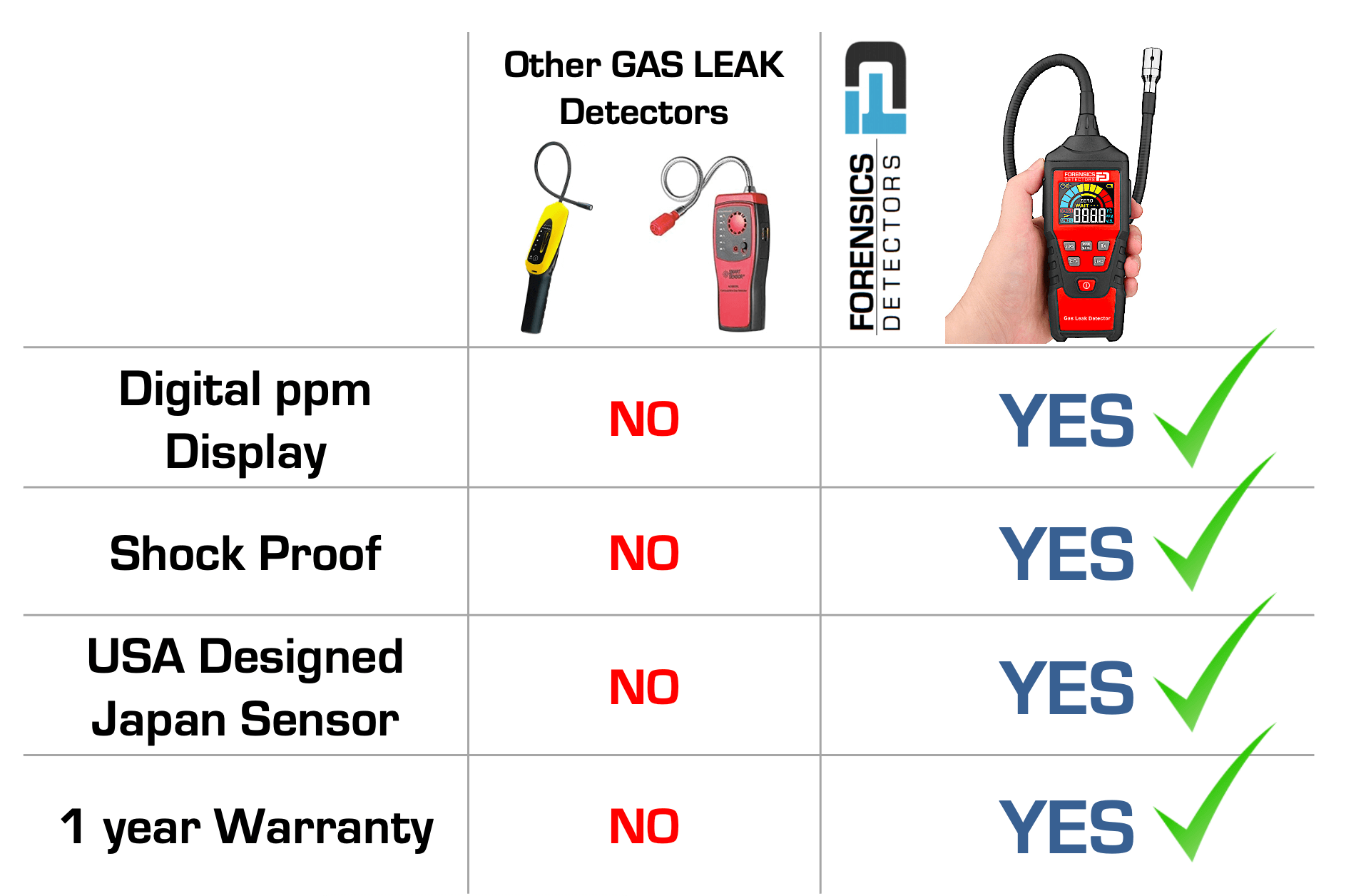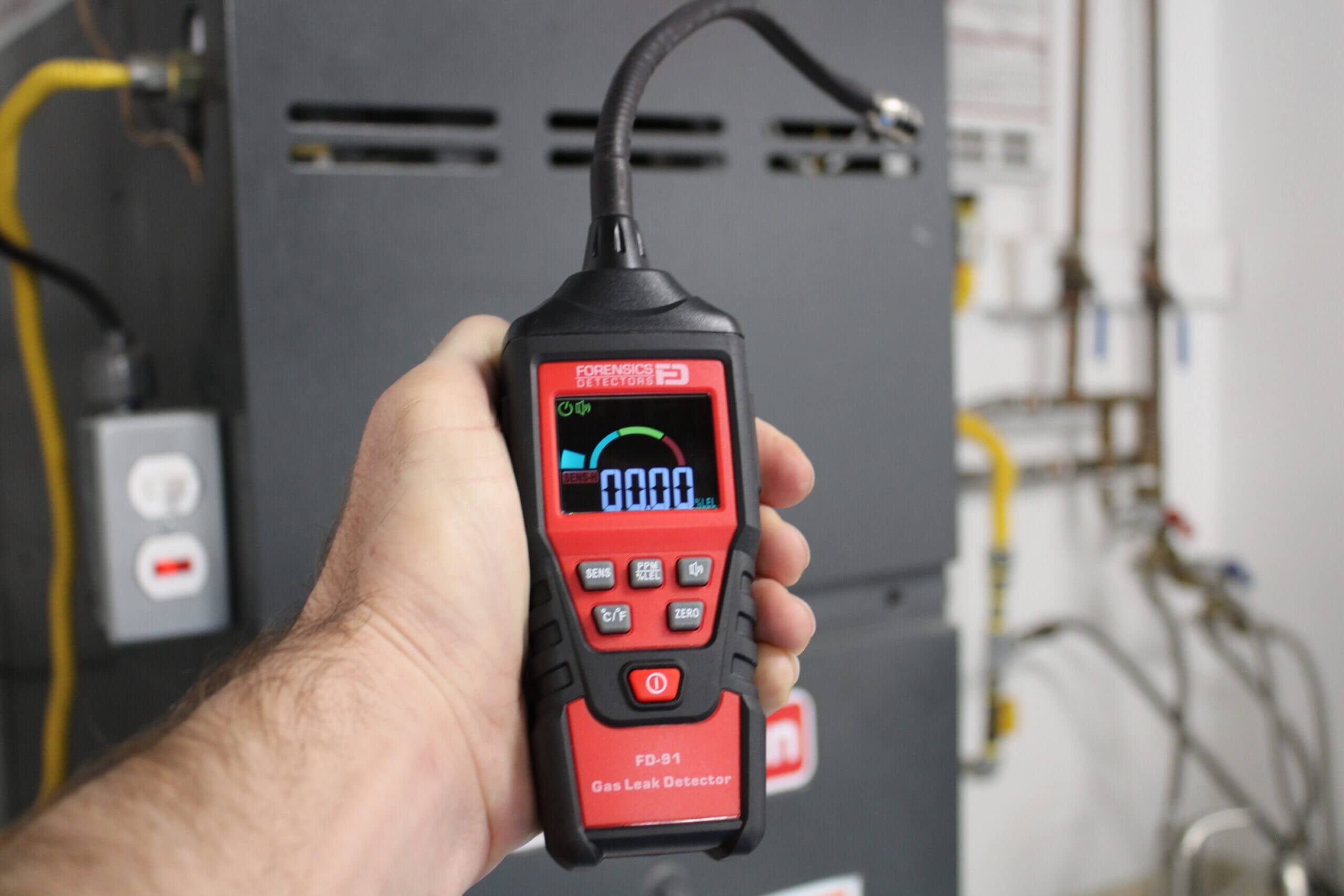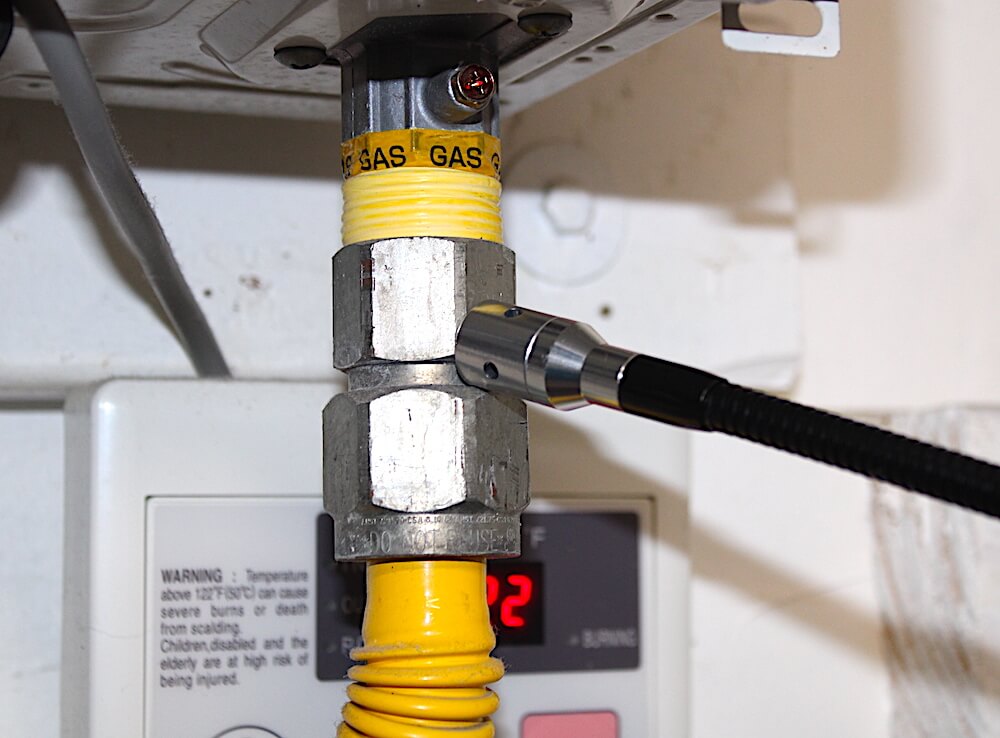A Natural Gas Leak Detector is a safety device designed to identify and locate natural gas leaks. It uses sensitive sensors to detect methane and other combustible gases, helping prevent dangerous gas accumulations in homes and buildings. These detectors provide early warning through audible alarms and digital readings.
Pros |
Cons |
|
✅ Safety Detection: Quickly identifies natural gas leaks for immediate response. ✅ Sensitivity: High-precision sensors detect even minimal gas concentrations. ✅ Portability: Handheld design allows easy access to various testing locations. ✅ Versatility: Works in both residential and commercial environments. |
⛔ Calibration: Requires Requires regular calibration to maintain accuracy. ⛔ Battery Management: Limited operating time on battery power. ⛔ Environmental Factors: Temperature and humidity can affect readings. ⛔ Maintenance: Regular sensor checks and replacements needed. |
What Is The Best Natural Gas Leak Detector?
There are various natural gas leak detectors on the market to choose from and it can get confusing. Some good option include:
- Forensics Detectors Gas Leak Detector | Natural Gas
- Sensit Gas Detector and Combustible Leaks
- Klein Gas Leak Detector
- RIDGID Combustible and Natural Gas Detector
-
Kane UEI Gas Leak Detector
Which Combustible Gases Can be Detected?
Detectable Gases detected by the Natural Gas Leak detector include: Acetone, Acetylene, Alcohol, Ammonia, Butane, Ethanol, Ethylene Oxide, Gasoline, Hexane, Methane, Naphtha, Natural Gas, Paint Thinners, Propane, and various Solvents.
Who Uses a Natural Gas Leak Detector?
Several individuals and professionals use natural gas leak detectors for various purposes. Here are some examples:
Homeowners: Homeowners use natural gas leak detectors to ensure the safety of their homes. These detectors are typically used forgas appliances, such as stoves, water heaters, and furnaces, to detect any gas leaks.
Property Managers: Property managers utilize natural gas leak detectors in residential and commercial buildings to protect the occupants and prevent gas-related accidents. These detectors help ensure compliance with safety regulations and provide prompt detection and response to gas leaks.
Utility Companies: Gas utility companies use natural gas leak detectors to inspect their infrastructure, including pipelines and distribution networks. These detectors assist in locating and identifying gas leaks.
Industrial Facilities: Industries that use natural gas as a fuel source, such as manufacturing plants, power plants, and refineries, employ gas leak detectors to monitor their operations. These detectors help prevent potential explosions, fires, or health hazards caused by gas leaks in industrial settings.
Emergency Response Teams: Firefighters, hazardous material response teams, and other emergency response personnel use natural gas leak detectors during gas leak incidents.
Environmental Agencies: Environmental agencies and regulatory bodies may use natural gas leak detectors to monitor and detect gas leaks in natural gas production, storage, and distribution facilities. This helps ensure compliance with environmental regulations and minimize the impact of gas leaks on the environment.

What about Natural Gas Bump Testing?
Ensuring the proper operation of your natural gas leak detector is crucial. To confirm its functionality and build confidence, it is recommended to perform a bump test. This involves exposing the gas leak detector to natural gas or methane bump gas, which is sprayed on the sensor to induce a positive response.
If you do not have methane bump gas, you can simply expose the gas sensor to some stovetop gas to induce and confirm a reaction.

What is Natural Gas?
Natural gas is primarily made up of methane (CH4). Here are the main components typically found in natural gas:
- Methane (CH4): Methane is the primary component of natural gas, typically making up 70-90% or more of its composition. It is a highly flammable and potent greenhouse gas.
- Ethane (C2H6): Ethane is often present in natural gas in smaller quantities, typically ranging from 0-20%. It is commonly used as a feedstock for the petrochemical industry.
- Propane (C3H8): Propane is another component of natural gas, usually found in smaller amounts, around 0-10%. It is commonly used as a fuel for heating, cooking, and as a feedstock for the production of petrochemicals.
- Butane (C4H10): Butane is a component that may be present in natural gas, typically in trace amounts.
- Carbon Dioxide (CO2): Carbon dioxide is a non-combustible component of natural gas, usually present in small quantities, ranging from 0-10%.
-
Nitrogen (N2): Nitrogen is often found in natural gas, with concentrations varying from 0-10% or higher. It is an inert gas and does not contribute to the combustible properties of natural gas.
Additionally, natural gas can contain trace amounts of other gases, such as hydrogen sulfide (H2S), helium (He), and various impurities, which can be removed during processing and purification.
The composition of natural gas can vary depending on the source and location. Natural gas extracted from different fields or regions may have different proportions of these components, and the specific composition can impact its energy content, combustion characteristics, and potential applications.

What Does A Natural Gas Leak Smell Like?
A natural gas leak typically smells like rotten eggs or sulfur. This is because natural gas is odorless in its natural state, so a chemical called mercaptan is added to give it a distinct odor that can be easily detected. If you smell this odor, it is important to evacuate the area immediately and call your gas company or emergency services.
How to Detect a Natural Gas Leak?
If you suspect you have a natural gas leak, you should use a tool such as a Natural Gas Leak Detector.
- Begin by turning on the Natural Gas Leak Detector and allowing it to start operating after the countdown.
- Next, perform a quick bump test to ensure the analyzer is functional. You can do this by exposing it to some natural gas or propane from your stovetop or other controlled source. The point here is to confirm the Natural Gas Leak Detector is indeed operating.
- Once you have completed the bump test, take the Natural Gas Leak Detector and scan the area of interest, moving about 2 seconds per inch. Be patient and thorough to ensure you capture any natural gas.
- Typical areas of leakage occur at gas lines, joints, valves, and fittings, as well as around the gas appliances. Make sure to check these locations.
- Observe the detector's response. The units have a digital readout in PPM and %LEL so it is very sensitive.
- If you have confirmed a gas leak, ensure you take appropriate action to maximize safety. This may involve turning off the gas supply, evacuating the area, and contacting a qualified professional or emergency services to address the situation.
How Long Does the Natural Gas Sensor Last?
Our Natural Ga Leak Detector is equipped with a made-in-Japan solid-state thermal semiconducting metal oxide sensor element. This is good news as these sensors have a much longer lifespan than traditional electrochemical gas sensors. In fact, semiconducting metal oxide sensors can last up to 10 years, whereas electrochemical gas sensors and catalytic gas sensors typically last only 2-3 years.
What are Safe Natural Gas Levels?
A natural gas leak can be dangerous as the combustible natural gas can accumulate creating a flammable and explosive situation.
Methane (CH4) is highly flammable and is explosive when levels are between 5% to 15% volume.
Even if the levels do not increase to explosive levels, OSHA has set the permissible exposure limit for methane at 1,000 parts per million (ppm) as a time-weighted average (TWA) for an 8-hour workday. NIOSH has a recommended exposure limit (REL) of 1,000 ppm for methane as a TWA.
Furthermore, we recommend if you do detect ANY gas leak of a combustible, such as natural gas, it MUST be addressed. Otherwise, the leak can increase and cause a major safety hazard.
Will a Natural Gas Leak set off Carbon Monoxide Detector?
No, a natural gas leak will not set off a carbon monoxide (CO) detector. Carbon monoxide detectors are specifically designed to detect and alert occupants to the presence of carbon monoxide gas.
Natural gas, on the other hand, primarily consists of methane (CH4) and no trace of carbon monoxide is within it.
How Reliably Can The Human Nose Detect Natural Gas Leaks?
The human nose can detect natural gas leaks through the added mercaptan odorant, typically sensing concentrations as low as 0.3%. However, detection reliability varies significantly based on individual sensitivity and environmental conditions.
How Should I Store my Natural Gas Leak Detector?
To ensure maximum sensor life and accurate measurements upon operation, it is recommended to store the Natural Gas Leak Detector in a moderate environment with a humidity level of 50%RH and a room temperature of approximately 70F. The unit should be kept in the hard waterproof case it was sold with for optimal storage conditions.
Conclusion
- A natural gas leak detector is a device designed to find natural gas leaks along gas lines, connections, and appliances.
- They help identify and locate potential gas leaks to prevent accidents, fires, or explosions.
- Natural Gas Leak Detectors include combustible sensor components that are sensitive to methane, which is the primary component of natural gas.
- Natural gas leak detectors provide visual and audible alarms to alert users when gas concentrations reach potentially hazardous levels.
- They are used in various settings, including residential homes, commercial buildings, industrial facilities, and by professionals such as inspectors, technicians, and emergency response teams.
About The Author
Dr. Kos Galatsis ("Dr.Koz") is the President of FORENSICS DETECTORS where the company operates from the scenic Palos Verdes Peninsula in Los Angeles, California. He is a subject matter expert on gas sensor technology, gas detectors, gas meters, and gas analyzers. He has been designing, building, manufacturing, and testing toxic gas detection systems for over 20 years.

Every day is a blessing for Dr. Koz. He loves to help customers solve their unique problems. Dr. Koz also loves spending time with his wife and his three children going to the beach, grilling burgers, and enjoying the outdoors.
Read more about Forensics Detectors here.
Email: drkoz@forensicsdetectors.com

